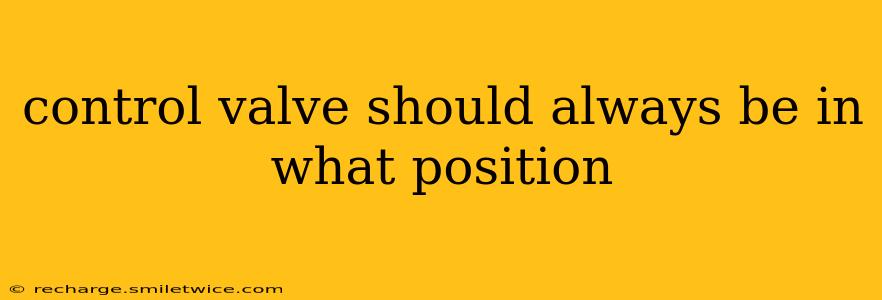Control Valve Positioning: A Comprehensive Guide
Control valves are essential components in countless industrial processes, regulating the flow of liquids, gases, and slurries. Understanding the optimal positioning of these valves is crucial for efficient operation, safety, and preventing costly equipment damage. While there's no single "always" position, the ideal placement depends heavily on the specific application and process requirements. However, we can explore best practices and common scenarios.
What is the normal position of a control valve?
The "normal" position of a control valve is determined during the design phase and depends on several factors:
-
Safety: In many processes, the safest position is one that prevents hazardous conditions. For instance, a valve controlling a potentially explosive gas might be normally closed, immediately halting flow in case of a system failure. Conversely, a valve supplying essential cooling water to a reactor might be normally open to prevent overheating.
-
Process Requirements: The process itself dictates the normal position. A valve controlling the feed of raw materials to a production line is likely normally open during operation, while a valve controlling a bypass stream might be normally closed unless required.
-
Maintenance: Accessibility for maintenance and repair is a critical consideration. A valve in a difficult-to-reach location might be designed with a normally closed position to minimize the risk of accidental activation during maintenance.
In summary, there isn't a universal "normal" position. It's a critical design parameter carefully considered based on the specific application's safety and operational needs.
What position should a control valve be in when not in use?
When a control valve is not in use, its ideal position depends again on the specific application and associated risks.
-
Fail-Safe Position: Many control valves are designed with a "fail-safe" position. This is the position the valve will assume in the event of a power failure or other malfunction. This is often a closed position for safety-critical applications.
-
Maintenance Considerations: If the valve is undergoing maintenance, it might be placed in a position that isolates it from the process stream, often fully closed to prevent accidental activation or leakage.
-
Long-Term Storage: For long-term storage, valves are often left in a position that minimizes internal stress and the risk of damage. This might involve a partially open position, or a position specified by the valve manufacturer. Always consult the manufacturer's recommendations for long-term storage.
Should a control valve always be fully open or closed?
No, a control valve should rarely be fully open or fully closed during normal operation. The purpose of a control valve is to precisely regulate flow, and this requires operating within its designed range. Fully open or closed positions might:
- Damage the valve: Frequent full-stroke operation can cause wear and tear, shortening the valve's lifespan.
- Lead to inaccurate control: At the extreme ends of the stroke, the valve's performance may be less precise.
- Increase energy consumption: Unnecessary full opening might lead to excess flow and wasted energy.
Exception: Certain applications might call for full opening or closing as part of their normal operation, such as a shutoff valve used to completely isolate a section of a pipeline. However, even then, the valve should be in good working order and inspected regularly.
What are the different types of control valves?
There is a wide variety of control valve types tailored to different applications and fluids, and each requires unique considerations for optimal positioning. Some common types include:
- Globe Valves: Commonly used for throttling and precise flow control.
- Ball Valves: Often used for on/off service, less suitable for precise throttling.
- Butterfly Valves: Suitable for larger lines and less precise throttling.
- Diaphragm Valves: Often used for corrosive or viscous fluids.
Each type has its own operational characteristics that impact the best positioning strategies.
How do I determine the correct position for my control valve?
Determining the correct position for your control valve requires careful consideration of many factors, including:
- Process Safety: Identify potential hazards and choose a position that minimizes risk.
- Process Requirements: Understand how the valve's position affects the overall process.
- Valve Type and Specifications: Consult the manufacturer's documentation for recommendations.
- Industry Best Practices: Follow established guidelines for your specific industry and application.
It is strongly recommended to consult with experienced process engineers or control system specialists to ensure proper valve positioning and safe operation. Improper valve positioning can result in significant risks, from process upsets to equipment damage and safety hazards.
